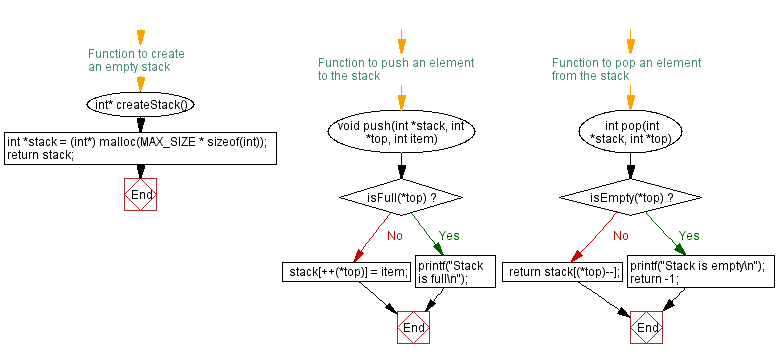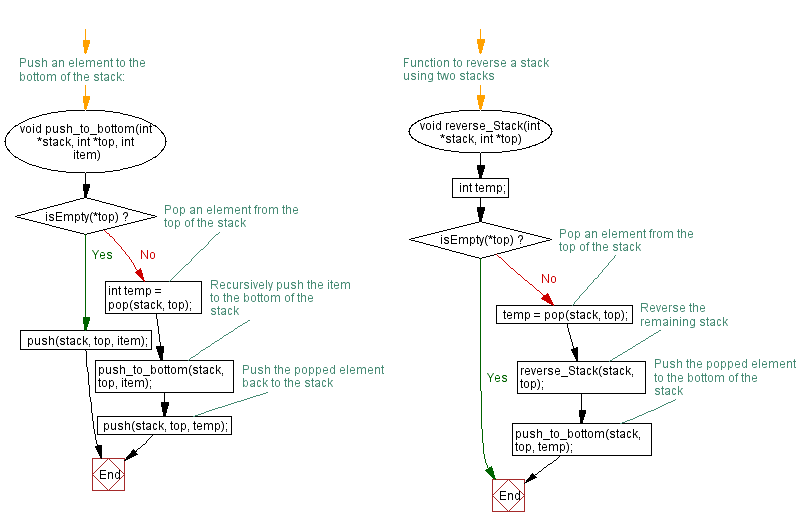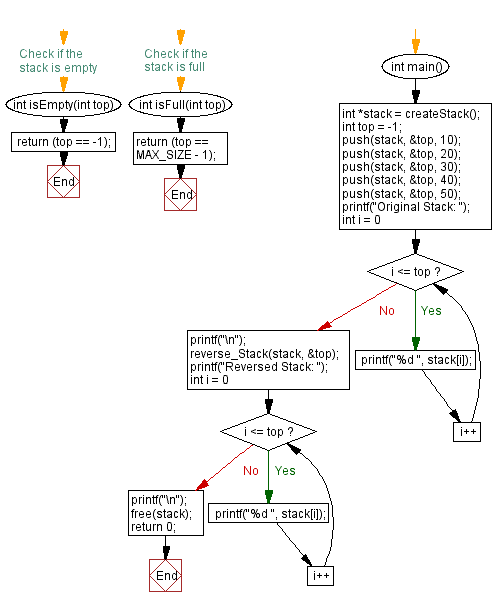C Exercises: Reverse a stack using push and pop
10. Reverse Stack Using Stack Ops
Write a C program that reverses a stack using only stack operations push and pop.
Sample Solution:
C Code:
#include <stdio.h>
#include <stdlib.h>
#define MAX_SIZE 100
// Function to create an empty stack
int* createStack() {
int *stack = (int*) malloc(MAX_SIZE * sizeof(int));
return stack;
}
// Check if the stack is empty
int isEmpty(int top) {
return (top == -1);
}
// Check if the stack is full
int isFull(int top) {
return (top == MAX_SIZE - 1);
}
// Function to push an element to the stack
void push(int *stack, int *top, int item) {
if (isFull(*top)) {
printf("Stack is full\n");
return;
}
stack[++(*top)] = item;
}
// Function to pop an element from the stack
int pop(int *stack, int *top) {
if (isEmpty(*top)) {
printf("Stack is empty\n");
return -1;
}
return stack[(*top)--];
}
// Push an element to the bottom of the stack
void push_to_bottom(int *stack, int *top, int item) {
if (isEmpty(*top)) {
push(stack, top, item);
} else {
// Pop an element from the top of the stack
int temp = pop(stack, top);
// Recursively push the item to the bottom of the stack
push_to_bottom(stack, top, item);
// Push the popped element back to the stack
push(stack, top, temp);
}
}
// Function to reverse a stack using two stacks
void reverse_Stack(int *stack, int *top) {
int temp;
if (isEmpty(*top)) {
return;
} else {
// Pop an element from the top of the stack
temp = pop(stack, top);
// Reverse the remaining stack
reverse_Stack(stack, top);
// Push the popped element to the bottom of the stack
push_to_bottom(stack, top, temp);
}
}
int main() {
int *stack = createStack();
int top = -1;
push(stack, &top, 10);
push(stack, &top, 20);
push(stack, &top, 30);
push(stack, &top, 40);
push(stack, &top, 50);
printf("Original Stack: ");
for (int i = 0; i <= top; i++) {
printf("%d ", stack[i]);
}
printf("\n");
reverse_Stack(stack, &top);
printf("Reversed Stack: ");
for (int i = 0; i <= top; i++) {
printf("%d ", stack[i]);
}
printf("\n");
free(stack);
return 0;
}
Output:
Original Stack: 10 20 30 40 50 Reversed Stack: 50 40 30 20 10
Flowchart:



For more Practice: Solve these Related Problems:
- Write a C program to reverse the order of elements in a stack without using any additional data structures.
- Write a C program to reverse a stack and then sort it, using only push and pop operations.
- Write a C program to reverse a stack recursively using only stack operations.
- Write a C program to reverse only the bottom half of a stack using push and pop operations.
Go to:
PREV : Dual Stack Array Operations.
NEXT : Find the minimum element in a stack.
C Programming Code Editor:
Have another way to solve this solution? Contribute your code (and comments) through Disqus.
What is the difficulty level of this exercise?
Test your Programming skills with w3resource's quiz.
